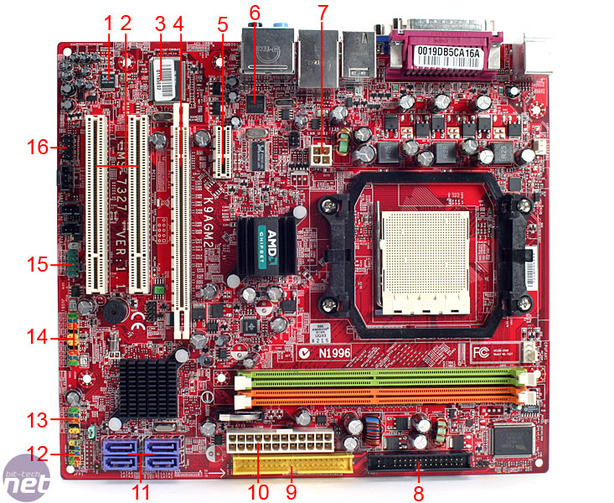MSI K9AGM2 board layout
We touched on this motherboard back when AMD first launched its 690G chipset in February, but we’ll now go into a bit more depth on this board specifically. The MSI features a classic red PCB and clearly coloured components. It may have no overall theme but all the ports and sockets are easily distinguishable.The Micro ATX motherboard provides more real estate over that of the mini-ITX, but obviously requires a bigger case. That’s no problem if you’re looking for something to fit in with your current A/V equipment but quite a concern if it’s going to sit next to your Wii.
First of all you can put in any socket AM2 processor in here, and combined with the PCI-Express x16 port and a couple of GB of memory makes this a potentially very powerful gaming or multimedia machine. The more functionality you throw in, the bigger the heatsinks, case and PSU need to be to accommodate the increased power requirements: you can’t get away with a 120W DC-DC PSU.
However the 690G also features a Radeon X1250 GPU built in which offers HDMI and VGA out simultaneously, helping to retain the low profile status. Combining this with an energy efficient Athlon X2 BE-2350 AMD CPU meant we had a very low power system that could be powered by the same 120W DC-DC PSU the EPIA ran on. However the GPU doesn't include UVD like the latest generation of HD 2000-series ATI graphics processors and isn't powerful enough to offer HD DVD and Blu-ray playback; that will still be done on the CPU. The GPU does does still come complete with ATI's Avivo technology though.


There are two memory slots for dual channel memory, although you can load them up to take 4GB if necessary. There’s also a black floppy port, yellow IDE port and four purple SATA ports along the edge of the board as well for easy access. However they're positioned in such a way that two of these are completely unusable as soon as you install a dual-slot graphics card. MSI is obviously banking on people not doing that though, especially considering the board is aimed at the mainstream / home theatre market.
The 24-pin ATX socket is along the same edge too which provides ease of access, but unfortunately you will need to stretch a 4-pin 12V cable across to the other side of the board. The northbridge has a tiny fanless heatsink, which is especially impressive when you consider there is a DX9 compliant graphics core underneath. The southbridge also uses an appreciably low profile fanless heatsink too, meaning it's possible to completely passively cool the system without having to modify the board's cooling solutions.
In terms of expansion ports, there is one PCI-Express x1, one PCI-Express x16 and two PCI ports provided; this offers a variety of connectivity for just 7cm more board length. The extra Firewire pin-out is in green but the front panel audio, S/PDIF and TV-out are all in black dotted around the board. The six extra USB 2.0 ports via three sets of pin-outs are colour coordinated according to what colour wire goes where, which is very helpful but can be easily confused when the front panel pin-out also uses the same colours and is placed right next to them.
There’s no TV-in here or special features like LVDS support, however you can get component out from a PCI-Express adapter card which unfortunately isn’t supplied. Realtek ALC888 is the High-Definition audio codec of choice, supporting 7.1 channel surround sound up to 24-bit / 129KHz. No extra Dolby or DTS functions are available with this chipset and there are specific ATI drivers (not included on the MSI CD!) for the S/PDIF passthrough for the HDMI port to make it compatible with HDCP content protection.

MSI MPG Velox 100R Chassis Review
October 14 2021 | 15:04









Want to comment? Please log in.